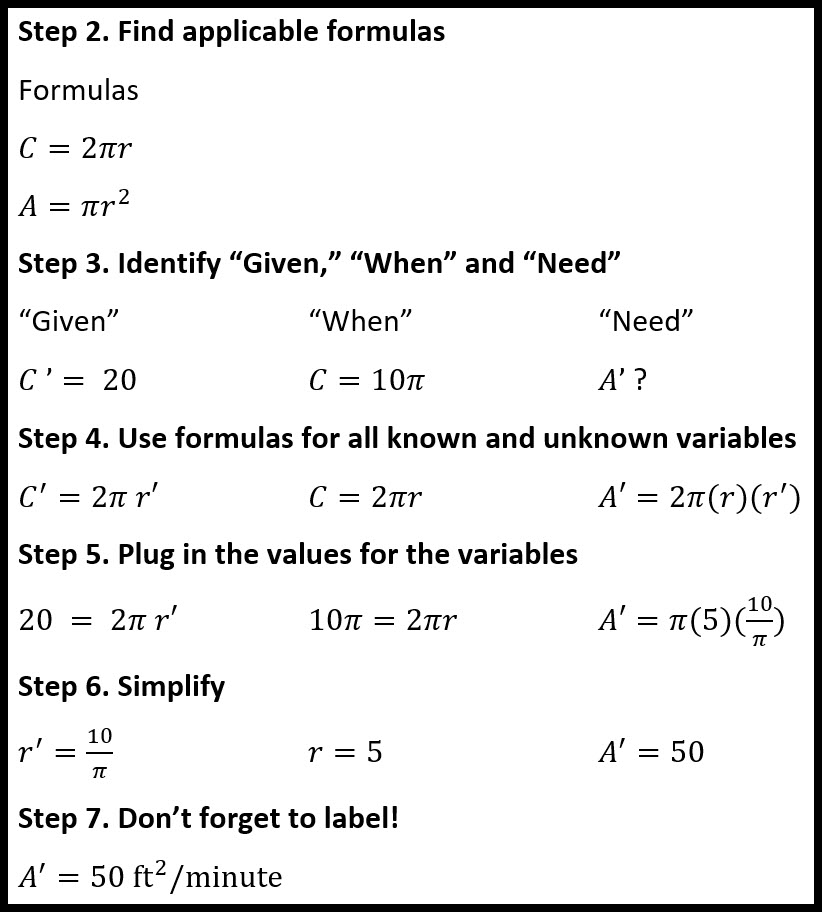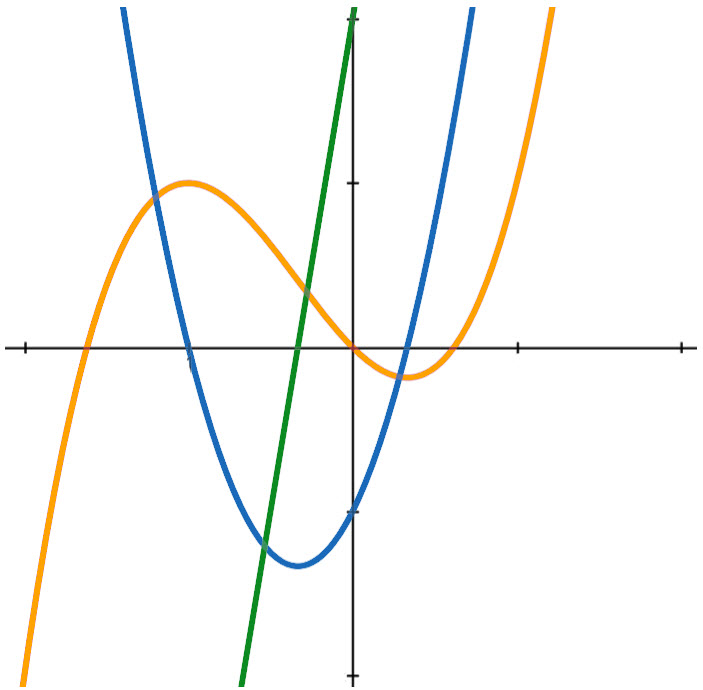Andymath.com features free videos, notes, and practice problems with answers! Printable pages make math easy. Are you ready to be a mathmagician?
Problems & Videos
\(\textbf{1)}\) \( y=x^2, \frac{dx}{dt}=5, \) Find \(\frac{dy}{dt}\) when \(x=2.\)

\(\textbf{2)}\) \( y=\sqrt[3]{x}, \frac{dx}{dt}=6, \) Find \( \frac{dy}{dt} \) when \( x=1. \)

\(\textbf{3)}\) \( xy=8, \frac{dx}{dt}=6, \) Find \( \frac{dy}{dt} \) when \( x=8 \)

\(\textbf{4)}\) The radius of a circle is increasing at a rate of 2 inches per minute. What rate is the area of the circle changing when the radius is 10 inches?

\(\textbf{5)}\) A sphere’s volume is increasing at 100 cubic meters per hour. How fast is the radius increasing when the radius is 10 meters?

\(\textbf{6)}\) The edges of a cube are expanding at a rate of 2 feet per minute. How fast is the volume changing when each edge is 4 feet?

\(\textbf{7)}\) A square has sides increasing at a rate of 4 m/s. At what rate is the area of the square increasing when the area is \( 25 m^2 \)?

\(\textbf{8)}\) A cylindrical tank has a fixed radius of 5 ft. The tank is being filled with water at a rate of 4 cubic feet per minute. How fast is the depth of the water increasing?

\(\textbf{9)}\) A sphere has a radius increasing at 3 ft/minute. How fast is the volume increasing when the surface area of the sphere is 100 \(\pi \) square feet?

\(\textbf{10)}\) A sphere has a radius increasing at a rate of 6 mm/s. How fast is the surface area of the sphere changing when the diameter is 10 mm?

\(\textbf{11)}\) A plane is flying above a school. Its altitude is 1 mile. Its speed is 200 mph. At what rate is the distance between the plane and school changing when the plane is 5 miles from the school?

\(\textbf{12)}\) Two planes leave the same point at the same time. 1 plane flies east at 200 mph. The other plane flies south at 150 mph. At what rate is the distance between the planes increasing 30 minutes after they take off?

\(\textbf{13)}\) A liquid spilled from a container spreads in a circle whose circumference increases at a rate of 10 in/sec. How fast is the area of the spill increasing when the circumference of the circle is 30\(π\) inches?
\(\textbf{14)}\) The volume of a sphere is increasing at a rate of \( 8π \) \( in^3\)/sec. How fast is the radius of the balloon increasing when the radius is 2 in?

\(\textbf{15)}\) 2 cars leave a town at the same time. The first Car heads north at a rate of 40 mph and the second car heads west at a rate of 30 mph. How fast is the distance between the cars increasing after 2 hours?

\(\textbf{16)}\) A cylinder with fixed radius 5 meters is filling with fluid at a rate of 50\(π\) \(m^3 \)/ sec. How fast is the height increasing?
\(\textbf{17)}\) The sides of an equilateral triangle are increasing at the rate of 10 ft/min. How fast is the triangle’s area increasing when each side of the triangle is 15 inches long?
\(\textbf{18)}\) An inverted cone has a radius of 25 in and a depth of 15 in. If water is flowing out of the vertex of the container at a rate of 5\(π\) inches\(^3\)/minute, how fast is the depth of the water dropping when the water height is 5 inches?

\(\textbf{19)}\) A boat is being pulled towards a larger boat by a rope. The rope is attached to the larger boat 10 feet above the rope hook on the smaller boat. The rope is pulled in at a rate of 2 ft/sec. How fast is the smaller boat approaching the larger boat when 20 feet of rope is still out?

\(\textbf{20)}\) The current is decreasing at -2 amps/sec as the resistance increases at 15 ohms/sec. How fast is the voltage changing when the voltage is 20 volts and the current is 5 amps? Note: use V=IR.

Notes
Steps

Sample Layout

Common Formulas
Squares
Area\(=s^2 \enspace \enspace \) Perimeter\(=4s \)
Rectangles
Area\(=lw \enspace \enspace \) Perimeter\(=2l+2w \)
Circles
Area\(=πr^2 \enspace \enspace \) Circumference\(=2πr\)
Spheres
Volume\(=\frac{4}{3}πr^3 \enspace \enspace \) Surface Area\(= 4πr^2 \)
Cylinders
Volume\(= πr^2 h \enspace \enspace \) Surface Area\(= 2πr^2+2πrh \enspace \enspace \) Lateral Area\(= 2πrh \)
Cones
Volume\(= \frac{1}{3} πr^2 h\)
note: proportional triangles is popular inverted cones \(\frac{radius}{height}=\frac{x \enspace (new \enspace radius)}{depth \enspace of \enspace liquid} \)
Cubes
Volume\(= s^3 \enspace \enspace \) Surface Area\(=6s^2\)
Pythagorean Theorem
\(a^2+b^2=c^2\)
Electricity
\(V=IR\)
Angle of Elevation
\(\tan(\theta)=\displaystyle \frac{\text{opposite}}{\text{adjacent}}\)
See Related Pages\(\)
\(\bullet\text{ Calculus Homepage}\)
\(\,\,\,\,\,\,\,\,\text{All the Best Topics…}\)
\(\bullet\text{ Definition of Derivative}\)
\(\,\,\,\,\,\,\,\, \displaystyle \lim_{\Delta x\to 0} \frac{f(x+ \Delta x)-f(x)}{\Delta x} \)
\(\bullet\text{ Equation of the Tangent Line}\)
\(\,\,\,\,\,\,\,\,f(x)=x^3+3x^2−x \text{ at the point } (2,18)\)
\(\bullet\text{ Derivatives- Constant Rule}\)
\(\,\,\,\,\,\,\,\,\displaystyle\frac{d}{dx}(c)=0\)
\(\bullet\text{ Derivatives- Power Rule}\)
\(\,\,\,\,\,\,\,\,\displaystyle\frac{d}{dx}(x^n)=nx^{n-1}\)
\(\bullet\text{ Derivatives- Constant Multiple Rule}\)
\(\,\,\,\,\,\,\,\,\displaystyle\frac{d}{dx}(cf(x))=cf'(x)\)
\(\bullet\text{ Derivatives- Sum and Difference Rules}\)
\(\,\,\,\,\,\,\,\,\displaystyle\frac{d}{dx}[f(x) \pm g(x)]=f'(x) \pm g'(x)\)
\(\bullet\text{ Derivatives- Sin and Cos}\)
\(\,\,\,\,\,\,\,\,\displaystyle\frac{d}{dx}sin(x)=cos(x)\)
\(\bullet\text{ Derivatives- Product Rule}\)
\(\,\,\,\,\,\,\,\,\displaystyle\frac{d}{dx}[f(x) \cdot g(x)]=f(x) \cdot g'(x)+f'(x) \cdot g(x)\)
\(\bullet\text{ Derivatives- Quotient Rule}\)
\(\,\,\,\,\,\,\,\,\displaystyle\frac{d}{dx}\left[\displaystyle\frac{f(x)}{g(x)}\right]=\displaystyle\frac{g(x) \cdot f'(x)-f(x) \cdot g'(x)}{[g(x)]^2}\)
\(\bullet\text{ Derivatives- Chain Rule}\)
\(\,\,\,\,\,\,\,\,\displaystyle\frac{d}{dx}[f(g(x))]= f'(g(x)) \cdot g'(x)\)
\(\bullet\text{ Derivatives- ln(x)}\)
\(\,\,\,\,\,\,\,\,\displaystyle\frac{d}{dx}[ln(x)]= \displaystyle \frac{1}{x}\)
\(\bullet\text{ Implicit Differentiation}\)
\(\,\,\,\,\,\,\,\,\)
\(\bullet\text{ Horizontal Tangent Line}\)
\(\,\,\,\,\,\,\,\,\)
\(\bullet\text{ Mean Value Theorem}\)
\(\,\,\,\,\,\,\,\,\)
\(\bullet\text{ Related Rates}\)
\(\,\,\,\,\,\,\,\,\)
\(\bullet\text{ Increasing and Decreasing Intervals}\)
\(\,\,\,\,\,\,\,\,\)
\(\bullet\text{ Intervals of concave up and down}\)
\(\,\,\,\,\,\,\,\,\)
\(\bullet\text{ Inflection Points}\)
\(\,\,\,\,\,\,\,\,\)
\(\bullet\text{ Graph of f(x), f'(x) and f”(x)}\)
\(\,\,\,\,\,\,\,\,\)
\(\bullet\text{ Newton’s Method}\)
\(\,\,\,\,\,\,\,\,x_{n+1}=x_n – \displaystyle \frac{f(x_n)}{f'(x_n)}\)
In Summary
Related rates is a mathematical concept that involves finding the rate of change of one quantity in relation to the rate of change of another. This is often used in physics and engineering to solve problems involving rates of change of various quantities.
Related rates is covered in Calculus classes, learning about related rates is important because it allows us to understand and analyze real-world situations involving rates of change.
One common mistake that students make when working with related rates is failing to properly set up the problem. It is important to carefully identify the quantities that are changing and their rates of change, as well as any given information, in order to set up the problem correctly.
Other topics that are related to related rates include optimization, which involves finding the maximum or minimum value of a function, and parametric equations, which involve expressing a set of quantities as functions of a variable called a parameter.
About Andymath.com
Andymath.com is a free math website with the mission of helping students, teachers and tutors find helpful notes, useful sample problems with answers including step by step solutions, and other related materials to supplement classroom learning. If you have any requests for additional content, please contact Andy at tutoring@andymath.com. He will promptly add the content.
Topics cover Elementary Math, Middle School, Algebra, Geometry, Algebra 2/Pre-calculus/Trig, Calculus and Probability/Statistics. In the future, I hope to add Physics and Linear Algebra content.
Visit me on Youtube, Tiktok, Instagram and Facebook. Andymath content has a unique approach to presenting mathematics. The clear explanations, strong visuals mixed with dry humor regularly get millions of views. We are open to collaborations of all types, please contact Andy at tutoring@andymath.com for all enquiries. To offer financial support, visit my Patreon page. Let’s help students understand the math way of thinking!
Thank you for visiting. How exciting!